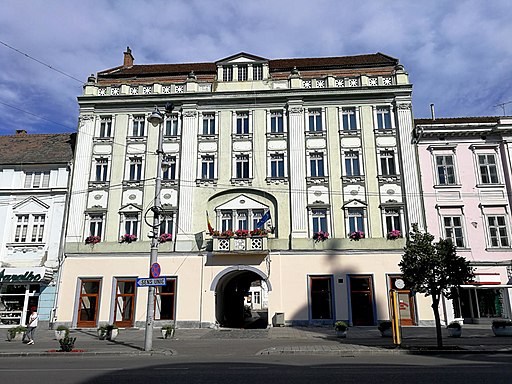Apolló Palace
Palatul Apollo
Apolló Palace
Palatul Apollo
Original function:
dancing / concert hall
theatre/opera
house
Address:
Piața Trandafirilor 5
Historical Hungarian county:
Maros-Torda
GPS coordinates:
46.5461618617, 24.5624922989
History
The palace was built by Count Teleki Sámuel between 1804 and 1807 with the aim of using the proceeds to maintain his library, the Teleki Library. The work was supervised by master builder Johannes Sommer from Kolozsvár. It was built in the late Baroque-neoclassical style. Originally it was a three-storey building, it had shops on the ground floor, apartments on the first floor and a ballroom on the second floor, where theatre performances were also held. The great hall was used for balls and dances, and was the main meeting place for the town's nobility in the 19th century. As Marosvásárhely did not have a stone theatre until the 1970s, from the 1820s onwards theatrical performances were also held in the Apollo Palace: in the Great Hall in winter and in inclement weather, and in summer on the stage set up in the garden in 1872 (Apollo Garden).
The palace is named after the Roman sun god Apollo, and the main hall is decorated with murals depicting Apollo.
The great hall was closed in 1891 due to fire hazards, and was replaced by the large hall of the old Transylvania Hotel. The Teleki heirs did not respect the will of Teleki Sámuel, and in 1923 they sold the palace to the brewer Bürger Albert, who in 1924 dismantled the interior of the building and, taking advantage of the second floor's ceiling height, divided it into two floors, creating suites. The reconstruction was based on the plans of Radó Sándor, and as a result the building lost its original Baroque character.
From 1923, the Hungarian Gentleman's Casino operated on the ground floor. The Vásárhely Meeting was held in the building in October 1937 with 187 participants, at which the representatives of the Transylvanian Hungarians declared that the idea of unity and the struggle for their rights should permeate all the institutions of their minority life, but that the possibility of peaceful coexistence between the Romanian and Hungarian peoples should also be sought. The meeting was chaired by the writer Tamási Áron.
{"item":"sight","set":{"sightId":2329,"townId":85,"active":1,"name_LO":"Palatul Apollo","address":"Pia\u021ba Trandafirilor 5","mapdata":"1|2410|2378","gps_lat":"46.5461618617","gps_long":"24.5624922989","religion":0,"oldtype":"92,91,53","newtype":"74","homepage":"","openinghours":"","muemlekemlink":"https:\/\/www.muemlekem.hu\/hatareset\/Apollo-palota-Marosvasarhely-1907","csemadoklink":"https:\/\/lexikon.adatbank.transindex.ro\/muemlek.php?id=413","picture":"\u003Ca title=\u0022Whitepixels, CC0, via Wikimedia Commons\u0022 href=\u0022https:\/\/commons.wikimedia.org\/wiki\/File:Tg.Mures_Palatul_Apollo_(2).jpg\u0022\u003E\u003Cimg width=\u0022512\u0022 alt=\u0022Tg.Mures Palatul Apollo (2)\u0022 src=\u0022https:\/\/upload.wikimedia.org\/wikipedia\/commons\/thumb\/4\/42\/Tg.Mures_Palatul_Apollo_%282%29.jpg\/512px-Tg.Mures_Palatul_Apollo_%282%29.jpg\u0022\u003E\u003C\/a\u003E","picture_ref":"\u003Ca href=\u0022https:\/\/commons.wikimedia.org\/wiki\/File:Tg.Mures_Palatul_Apollo_(2).jpg\u0022\u003EWhitepixels\u003C\/a\u003E, CC0, via Wikimedia Commons","name":"Apoll\u00f3 Palace","note":"","history":"The palace was built by Count Teleki S\u00e1muel between 1804 and 1807 with the aim of using the proceeds to maintain his library, the Teleki Library. The work was supervised by master builder Johannes Sommer from Kolozsv\u00e1r. It was built in the late Baroque-neoclassical style. Originally it was a three-storey building, it had shops on the ground floor, apartments on the first floor and a ballroom on the second floor, where theatre performances were also held. The great hall was used for balls and dances, and was the main meeting place for the town's nobility in the 19th century. As Marosv\u00e1s\u00e1rhely did not have a stone theatre until the 1970s, from the 1820s onwards theatrical performances were also held in the Apollo Palace: in the Great Hall in winter and in inclement weather, and in summer on the stage set up in the garden in 1872 (Apollo Garden).@\nThe palace is named after the Roman sun god Apollo, and the main hall is decorated with murals depicting Apollo.@\nThe great hall was closed in 1891 due to fire hazards, and was replaced by the large hall of the old Transylvania Hotel. The Teleki heirs did not respect the will of Teleki S\u00e1muel, and in 1923 they sold the palace to the brewer B\u00fcrger Albert, who in 1924 dismantled the interior of the building and, taking advantage of the second floor's ceiling height, divided it into two floors, creating suites. The reconstruction was based on the plans of Rad\u00f3 S\u00e1ndor, and as a result the building lost its original Baroque character.@\nFrom 1923, the Hungarian Gentleman's Casino operated on the ground floor. The V\u00e1s\u00e1rhely Meeting was held in the building in October 1937 with 187 participants, at which the representatives of the Transylvanian Hungarians declared that the idea of unity and the struggle for their rights should permeate all the institutions of their minority life, but that the possibility of peaceful coexistence between the Romanian and Hungarian peoples should also be sought. The meeting was chaired by the writer Tam\u00e1si \u00c1ron.\n&\nwikipedia: Apoll\u00f3-palota (Marosv\u00e1s\u00e1rhely)|https:\/\/hu.wikipedia.org\/wiki\/Apoll%C3%B3-palota_(Marosv%C3%A1s%C3%A1rhely)","town":{"townId":85,"name_HU":"Marosv\u00e1s\u00e1rhely","name_LO":"T\u00e2rgu Mure\u0219","seolink":"marosvasarhely-targu-mures","oldcounty":41,"country":4}},"language":"en","region":"romania","regionid":4,"offer":[],"gallery":false,"album":false}

